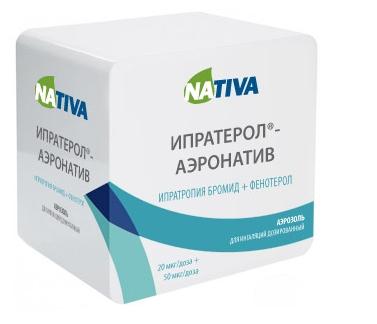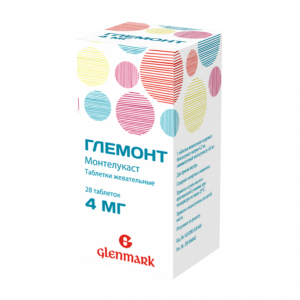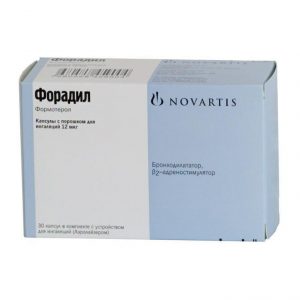Description
Dosage form
inhalation aerosol.
Pharmacological action
Pharmacotherapeutic group: combination bronchodilating agent ( 2-selective adrenergic agonist + m-anticholinergic blocker)
ATX code: R03AK03
Pharmacological properties Ipraterol-aeronative contains two components, possessing bronchodilator activity: ipratropium bromide m-anticholinergic and fenoterol 2-adrenergic agonist. Bronchodilation with the inhalation of ipratropium bromide is mainly due to local and not systemic anticholinergic action. Pharmacodynamics
Ipratropium bromide is a quaternary ammonium derivative with anticholinergic (parasympatolytic) properties. Ipratropium bromide inhibits the reflexes caused by the vagus nerve. Anticholinergics prevent an increase in the intracellular concentration of calcium ions, which occurs due to the interaction of acetylcholine with muscarinic receptors of the smooth muscles of the bronchi. The release of calcium ions is mediated by a system of secondary mediators, which include ITF (inositol triphosphate) and DAG (diacylglycerol). In patients with bronchospasm, associated with chronic obstructive pulmonary diseases (chronic bronchitis and pulmonary emphysema), a significant improvement in lung function (increase in forced expiratory volume in 1 second (FEV1) and peak expiratory flow rate (PSV) by 15% or more) is observed for 15 minutes, the maximum effect achieved in 1-2 hours and lasts in most patients up to 6 hours after administration. Ipratropium bromide does not adversely affect mucus secretion in the respiratory tract, mucociliary clearance and gas exchange. Fenoterol selectively stimulates 2-adrenergic receptors in a therapeutic dose. Stimulation of 1-adrenergic receptors occurs when using high doses. This explains the -Adrenergic (stimulating -Adrenoreceptors) effect of the drug on cardiac activity, such as an increase in the frequency and strength of heart contractions, QTc interval lengthening. Fenoterol relaxes the smooth muscles of the bronchi and blood vessels and counteracts the development of bronchospastic reactions due to the effects of histamine, methacholine, cold air and allergens (immediate hypersensitivity reactions). Immediately after administration, fenoterol blocks the release of inflammatory mediators and bronchial obstruction from mast cells. In addition, when using phenoterol in higher doses, an increase in mucociliary clearance was noted. When using fenoterol using metered-dose aerosol inhalers (DAIs), systemic effects are noted when doses exceeding the recommended ones are used. However, after applying fenoterol with nebulizers (inhalation solution in standard dose vials), the systemic effect may be higher. than when using the drug with DAI in recommended doses. The clinical significance of these observations has not been established. The most commonly observed effect of -Adrenoreceptor agonists ( -Adrenomimetics) is tremor. In contrast to the effects on the smooth muscles of the bronchi, tolerance may develop to the systemic effects of β-adrenoreceptor agonists, however, the clinical significance of this manifestation has not been elucidated. With the combined use of ipratropium bromide and fenoterol, the bronchodilating (bronchodilating) effect is achieved by acting on various pharmacological targets. These substances complement each other, as a result, the antispasmodic effect on the muscles of the bronchi is enhanced and a wide range of therapeutic effects is provided for bronchopulmonary diseases accompanied by airway obstruction. The complementary effect is such that to achieve the desired effect, a lower dose of the β-adrenergic component is required, which allows you to individually select an effective dose with almost no side effects. Pharmacokinetics There is no evidence that the pharmacokinetics of the combined drug is different from that of each of the individual components. Absorption of ipratropium bromide. After inhalation, 10-30% of the administered dose of the drug usually enters the lungs (depending on the dosage form and method of inhalation). Most of the dose is swallowed and enters the gastrointestinal tract. The part of the dose that reaches the lungs quickly reaches the systemic circulation (within a few minutes). The total systemic bioavailability of ipratropium bromide, used by inhalation, is 7-28%. Fenoterol. Depending on the method of inhalation and the inhalation system used, about 10-30% of the active substance reaches the lower respiratory tract, and the rest is deposited in the upper respiratory tract and swallowed. As a result, a certain amount of inhaled phenoterol enters the gastrointestinal tract. Absorption is of a two-phase nature – 30% of fenoterol is rapidly absorbed with a half-life (T1 / 2) of 11 minutes, and 70% is absorbed slowly from T1 / 2 – 120 minutes. There is no correlation between the concentrations of phenoterol in blood plasma achieved after inhalation and the pharmacodynamic curve “time – effect”. Long-term (3-5 hours) bronchodilating effect of the drug after inhalation, comparable to the corresponding effect achieved after intravenous administration, not supported by high concentrations of the active substance in the systemic circulation. Distribution of ipratropium bromide. A rapid two-phase decrease in plasma concentration is observed.
The apparent volume of distribution during the equilibrium concentration state (Css) is approximately 176 L ( 2.4 L / kg). Ipratropium bromide binds to plasma proteins to a minimum extent (less than 20%). Ipratropium bromide, which is a quaternary amine, does not penetrate the blood-brain barrier. There is no evidence of the possibility of penetration of ipratropium bromide through the placental barrier and into breast milk. Does not cumulate. Fenoterol. Fenoterol is intensively distributed over organs and tissues. The apparent volume of distribution during the equilibrium concentration state is approximately 189 L ( 2.7 L / kg). Communication with plasma proteins 40-55%. Fenoterol in unchanged form crosses the placental barrier and is excreted in breast milk. Metabolism ipratropium bromide. Metabolized by oxidation, mainly in the liver. Up to 8 ipratropium bromide metabolites are known, which weakly bind to muscarinic receptors and are considered inactive. Fenoterol. Metabolized in the liver. When swallowed, fenoterol undergoes biotransformation due to the effect of primary passage through the liver. A swallowed amount of the drug does not affect the concentration of the active substance in the blood plasma achieved after inhalation. The biotransformation of phenoterol in humans occurs by conjugation with glucuronides and sulfates. After oral administration, fenoterol is metabolized mainly by sulfation in the intestinal wall. Excretion of ipratropium bromide. It is excreted mainly through the intestines, as well as through the kidneys. About 25% is excreted unchanged, the rest – in the form of metabolites. Fenoterol. Biotransformation, including excretion with bile, undergoes the bulk of phenoterol – approximately 85%. The excretion of phenoterol with urine (0.27 L / min) corresponds to approximately 15% of the average total clearance of a systemically available dose. The volume of renal clearance indicates tubular secretion of phenoterol in addition to glomerular filtration. After inhalation of the metered-dose aerosol in an unchanged form, 2% of the dose is released through the kidneys within 24 hours. Pharmacokinetics in various groups.
The pharmacokinetics of the combination of ipratropium bromide and phenoterol in patients with diabetes mellitus has not been studied.
Indications
Prevention and symptomatic treatment of obstructive airway diseases with reversible airway obstruction (chronic obstructive pulmonary disease, bronchial asthma, chronic bronchitis, complicated or uncomplicated emphysema).
Pregnancy and lactation
Existing clinical experience has shown that fenoterol and ipratropium bromide do not have a negative effect on pregnancy. However, when using these drugs during pregnancy (second and third trimester), the usual precautions should be followed. The inhibitory effect of Ipraterol-Aeronativ on uterine contractility should be taken into account. Fenoterol passes into breast milk. For ipratropium bromide, such data have not been obtained. The safety of the drug during lactation has not been established. In this regard, the use of the drug Ipraterol-aeronat during lactation is possible only in cases where the potential benefit to the mother outweighs the potential risk to the child.
Special instructions
In the event of sudden rapid intensification of shortness of breath (shortness of breath), consult a doctor immediately. In children, the drug should be used only as directed by a doctor and under the supervision of adults.
Use in children under 6 years of age is contraindicated due to a lack of experience. Hypersensitivity: After the use of the drug Ipraterol-aeronativ, immediate hypersensitivity reactions may occur, the symptoms of which in rare cases can be: urticaria, Quincke’s edema, rash, bronchospasm, oropharyngeal edema, anaphylactic shock. Paradoxical bronchospasm: Ipraterol aeronativ, like other inhaled drugs, can cause paradoxical bronchospasm, which can be life-threatening. In the case of the development of paradoxical bronchospasm, the use of the drug Ipraterol-aeronativ should be stopped immediately and switch to alternative therapy.
Long-term use: – In patients with bronchial asthma, Ipraterol aeronativ should be used only as needed.
In patients with a mild form of chronic obstructive pulmonary disease, symptomatic treatment may be preferable to regular use – in patients with bronchial asthma, remember that it is necessary to conduct or strengthen anti-inflammatory therapy to control the inflammatory process of the respiratory tract and the course of the disease. The regular use of increasing doses of drugs containing 2-adrenergic agonists, such as Ipraterol-aeronativ, for relief of bronchial obstruction can cause an uncontrolled worsening of the disease. In the case of increased bronchial obstruction, an increase in the dose of 2-adrenergic agonists, including the drug Ipraterol-aeronativ, more than recommended for a long time, is not only unjustified, but also dangerous. To prevent a life-threatening worsening of the course of the disease, consideration should be given to revising the patient s treatment plan and adequate anti-inflammatory therapy with inhaled glucocorticosteroids. Other sympathomimetic bronchodilators should be prescribed simultaneously with the drug Ipraterol-aeronativ only under medical supervision. Gastrointestinal Disorders: In patients having a history of cystic fibrosis, gastrointestinal motility disorders are possible.
Disorders of the organ of vision: Ipraterol aeronativ should be used with caution in patients predisposed to angle-closure glaucoma. There are separate reports of complications from the organ of vision (for example, increased intraocular pressure, mydriasis, angle-closure glaucoma, eye pain) that developed when inhaled ipratropium bromide (or ipratropium bromide in the kidneytania with 2-adrenergic agonists) in the eyes. Symptoms of acute angle-closure glaucoma can be pain or discomfort in the eyes, blurred vision, the appearance of a halo around objects and colored spots in front of the eyes in combination with corneal edema and redness of the eyes due to conjunctival hyperemia. If any combination of these symptoms develops, the use of eye drops that reduce intraocular pressure is indicated, and immediate consultation with a specialist. Patients should be instructed on the proper use of the inhaled drug Ipraterol-aeronativ. Patients predisposed to the development of glaucoma should be especially careful about eye protection. Systemic effects: In diseases such as recent myocardial infarction (within the last 3 months), insufficiently controlled diabetes mellitus, severe organic diseases of the heart and blood vessels, hyperthyroidism, pheochromocytoma or obstruction of the urethra (for example, with prostatic hyperplasia or obstruction of the bladder neck) Ipraterol aeronativ should be used only after a thorough risk / benefit assessment. Effect on the cardiovascular system: Post-marketing studies have reported rare cases of myocardial ischemia when taking 2-adrenomimetics. Patients with concomitant serious heart diseases (for example, coronary heart disease, arrhythmias, or severe heart failure) receiving Ipraterol-aeronativ should be warned about the need to see a doctor in case of pain in the heart or other symptoms indicating worsening heart disease. It is necessary to pay attention to such symptoms as shortness of breath and chest pain, as they can be both cardiac and pulmonary etiology.
Hypokalemia: When using 2-adrenergic agonists, hypokalemia may occur (see section Overdose ). In athletes, the use of the drug Ipraterol-aeronat in connection with the presence of phenoterol in its composition can lead to positive results of doping tests. Influence on the ability to drive a car and other vehicles, on working with moving mechanisms No studies have been conducted to study the effect of the drug on the ability to drive vehicles and control mechanisms. In the event of the development of adverse reactions such as dizziness, tremors, impaired accommodation, mydriasis and blurred vision, you should refrain from driving vehicles and controlling mechanisms, as well as from practicing other potentially dangerous activities that require an increased concentration of attention and speed of psychomotor reactions.
Composition
Composition per 1 dose:
Active substances:
Ipratropium bromide monohydrate (in terms of ipratropium bromide) 0.021 mg (0.020 mg) Phenoterol gi bromromide 0.050 mg
Excipients: Absolute ethanol 15.300 mg
Citric acid monohydrate 0.005 mg
Triethyl citrate 0.150 mg
Propellant R 134a (1,1,1, 2-tetrafluoroethane) 44.470 m
Dosage and administration
Dose should be selected individually. Unless otherwise indicated by a physician, the following doses are recommended: Adults and children 6 years of age and older: Treatment of seizures In most cases, two inhaled doses of aerosol are sufficient to relieve symptoms. If breathing relief has not occurred within 5 minutes, an additional 2 inhalation doses may be used. If there is no effect after 4 inhalation doses and additional inhalations are required, you should immediately seek medical help. Intermittent and long-term therapy: 1-2 inhalations per dose, up to 8 inhalations per day (on average 1-2 inhalations 3 times a day). In bronchial asthma, the drug should be used only as needed. Ipraterol-aeronativ should be used in children only as prescribed by a doctor and under the supervision of adults (see section “Special instructions”).
Side effects of
Many of the undesirable effects listed above may be due to the anticholinergic and? -adrenergic properties of the drug Ipraterol-aeronativ. The use of the drug Ipraterol-aeronativ, like any inhalation therapy, can cause local irritation. Frequency determination: very often (> 1/10), often (from 1/100 to 1/10), infrequently (from 1/1000 to 1/100), rarely (from 1/10000 to 1/1000), very rarely (<1/10000). Immune system disorders: rarely - hypersensitivity reactions, anaphylactic reactions (Quincke's edema). Disorders from the side of metabolism and nutrition: rarely – hypokalemia. Mental disorders: infrequently – nervousness rarely – a sense of anxiety, mental disturbances (mental disorders). Disorders of the nervous system: infrequently – headache, dizziness, tremor. Disorders of the organ of vision: rarely – glaucoma, increased intraocular pressure, impaired accommodation, mydriasis, blurred vision, eye pain, corneal edema, conjunctival hyperemia, the appearance of a halo around objects and colored spots in front of the eyes. Heart disorders: infrequently – tachycardia, rarely palpitations – arrhythmia, atrial fibrillation, atrial fibrillation, supraventricular tachycardia, myocardial ischemia. Disorders of the respiratory system, chest and mediastinal organs: often – cough infrequently – pharyngitis, dysphonia rarely – bronchospasm, pharyngeal irritation, pharyngeal edema, laryngospasm, paradoxical bronchospasm, dry throat. Disorders of the gastrointestinal tract: infrequently – vomiting, dry mouth, nausea rarely – stomatitis, glossitis, gastrointestinal motility, diarrhea, constipation, swelling of the oral cavity. Disorders of the skin and subcutaneous tissue: rarely – urticaria, skin rash, itching, sweating. Violations of the musculoskeletal and connective tissue: rarely – muscle weakness, myalgia (muscle pain), muscle spasm. Disorders of the kidneys and urinary tract: rarely – urinary retention. Laboratory and instrumental data: infrequently – increased systolic blood pressure rarely – increased and decreased diastolic blood pressure. If any of the side effects indicated in the instructions are aggravated or you notice any other side effects not listed in the instructions, inform your doctor. Drug interactions Concomitant use of other? -adrenomimetic drugs, anticholinergics, including systemic action, and xanthine derivatives (for example, theophylline) can enhance the bronchodilating effect of the drug Ipraterol-aeronativ and lead to aggravation of side effects. A significant weakening of the bronchodilatory effect of the drug is possible with the simultaneous administration of? -Adrenoblockers. Hypokalemia associated with the use of? -Adrenomimetics can be enhanced by the simultaneous administration of xanthine derivatives, glucocorticosteroids and diuretics. This fact should be given special attention in the treatment of patients with severe forms of obstructive airway disease. Hypokalemia can lead to an increased risk of arrhythmias in patients receiving digoxin. In addition, hypoxia can increase the negative effect of hypokalemia on heart rate. In such cases, it is recommended to monitor serum potassium levels. Caution is required to prescribe? 2-adrenergic agents to patients receiving monoamine oxidase inhibitors, tricyclic antidepressants, L-dopa, L-thyroxine, oxytocin, since these drugs can enhance the effect of? -Adrenergic agents. Inhalation of general anesthetics such as halogenated hydrocarbon anesthetics (halothane, trichlorethylene, enflurane), may enhance the adverse effect of? – adrenergic agents on the cardiovascular system. Overdose Symptoms Overdose symptoms are associated primarily with phenoterol. Symptoms may occur due to over-stimulation of -Adrenoreceptors. The most likely occurrence of tachycardia, palpitations, tremors, hypertension or arterial hypotension, an increase in the difference between systolic and diastolic blood pressure, angina pectoris, arrhythmias and feelings of flushing of the face, hyperglycemia, metabolic acidosis, hypokalemia. Possible symptoms of an overdose of ipratropium bromide (such as dry mouth, impaired accommodation), given the large breadth of the therapeutic effect of the drug and the local method of use, are usually mild and transient. Treatment It is necessary to stop taking the drug. Consideration should be given to monitoring the acid-base balance of the blood. Sedatives, tranquilizers are indicated, in severe cases intensive care. As a specific antidote, β-blockers, preferably β-selective blockers, can be used. However, one should remember the possible increase in bronchial obstruction under the influence of β-blockers and carefully select a dose for patients suffering from bronchial asthma or chronic obstructive pulmonary disease, due to the risk of severe bronchospasm, which can lead to death. Storage conditions In a dark place at a temperature not exceeding 25 ° C, away from heaters. Do not freeze. Keep out of reach of children. Expiration 2 years. Do not use the product after the expiry date. active substance Ipratropium bromide, Fenoterol lekarstvennaja form aerosols for ynhalyatsyy Indications Indications Bronchospasm, Bronchial asthma, Low learning




